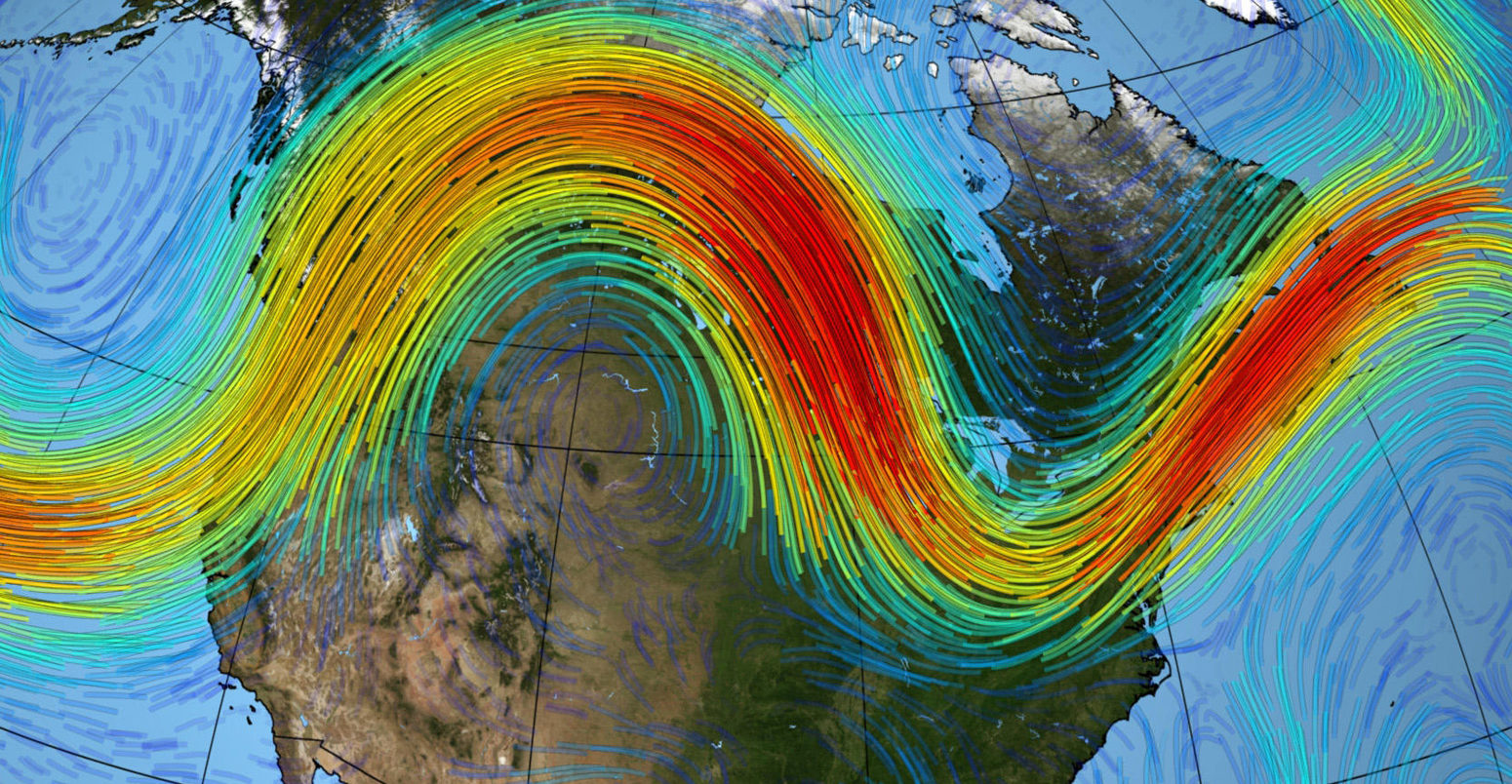
Jet stream: Is climate change causing more ‘blocking’ weather events?
Robert McSweeney
06.12.20Robert McSweeney
12.06.2020 | 1:13pmThe past few months have seen some remarkable weather, from the UK’s sunniest spring on record to Siberia’s dramatic heatwave and “zombie wildfires”.
Key to this unseasonable weather are persistent high-pressure “blocking” weather systems, which bring clear, dry conditions on the ground below for many days or weeks.
Blocking events bat away oncoming low-pressure systems that would bring the prospect of clouds and rain. They are particularly synonymous with heatwaves and drought in summer and bitterly cold conditions in winter.
But what are the prospects for blocking events in a warming climate? And could a rapidly warming Arctic also have a role to play?
In this Q&A, Carbon Brief takes a closer look at the causes of blocking events and the potential changes in the future.
- What is ‘blocking’?
- What causes blocking?
- Have blocking events changed as the climate has warmed?
- How might climate change affect blocking in future?
- What role does a warming Arctic play?
What is ‘blocking’?
Around the mid-latitudes of the northern hemisphere, low-pressure weather fronts, which bring cloudy, windy and potentially wet weather, generally move from west to east. These are carried along by the jet stream – a current of fast-flowing air high up in the troposphere, the lowest layer of the Earth’s atmosphere. (Jet streams encircle the mid-latitudes of both the northern and southern hemispheres.)
The jet generally keeps a steady stream of weather systems moving across the Earth’s surface. This means that any low-pressure system – or intervening high-pressure system that brings clear, still and sunny conditions – will generally only linger for a matter of days before being shunted on by the next system.
However, sometimes weather systems can get stuck in place for an extended period of time. This is known as “blocking”, explains Prof Tim Woollings, associate professor of physical climate science at the University of Oxford, Oxford joint chair of the Met Office Academic Partnership, and author of a book on the jet stream. He tells Carbon Brief:
“Blocking is a stationary and persistent weather pattern, most often an anticyclone [high-pressure system], that blocks the oncoming jet stream and storms.”
With a high-pressure weather system in the way, the oncoming weather is either deflected away or it, too, stays put. This can bring extended periods of consistent weather, says the UK’s Met Office:
“In terms of the weather you will get, this means that under the high pressure the weather will remain mainly dry and settled for a few days or perhaps weeks. However, if you are in the area where the weather fronts are, you are likely to get wet and windy weather for a long time.”
This persistent weather can cause extreme conditions. The UK has just experienced its sunniest and fifth driest spring on record, an extraordinary about-turn after the wettest February on record just months earlier. Prof Liz Bentley, chief executive of the Royal Meteorological Society, described this wet-to-dry shift as “unprecedented”.
As the Met Office explained in a guest post for Carbon Brief, the remarkable spring weather was a result of a blocking weather pattern:
“This spring, the jet stream buckled and shifted northward, allowing successive areas of high pressure to dominate the UK. These ‘blocking’ patterns of high pressure are the main reason for the extended periods of sunny, dry and relatively warm conditions that we have seen this spring.”
At the same time, the usually chilly expanse of Siberia has been simmering in unseasonable heat. Average temperatures during May, for example, were 10C above the norm – reigniting wildfires still simmering from last year. This extended period of heat was also the result of a blocking weather pattern.
Blocking is most common in spring, the Met Office says, but is often most associated with dramatic heatwaves in summer and severe cold during winter.
For example, blocking was a driver of the heat and drought of the UK’s 1976 summer, the deadly European summer heatwave of 2003, Siberia’s heatwaves and wildfires in the summer of 2013, and Europe’s extreme cold winter of 2009-10. A blocking pattern – in different positions – brought the US a record-breaking warm March in 2012 and record-breaking cold March in 2013.
Blocking has also been shown to affect the paths of tropical cyclones, potentially steering them on unusual tracks.
There are certain regions where blocking “preferentially occurs”, says Prof Len Shaffrey, professor of climate science at the University of Reading.
“In the northern hemisphere, these are on the northern and eastern sides of the North Atlantic and North Pacific Oceans – so for the North Atlantic that means over Greenland and Europe.”
The maps below, from a 2018 review paper by Woollings and colleagues, give an indication of the frequency of blocking events across the northern hemisphere over 1958-2012. They show the percentage of days in the season with blocking for winter (top) and summer (bottom) according to three different methods of characterising blocking events. The darker the orange shading, the more days of blocking.
The estimates vary quite a bit between method, region and season, Woollings notes, but “typical numbers for blocking regions – over Eurasia, the Atlantic and Alaska, for example – would be one or two events per season, with each event lasting about a week on average”.
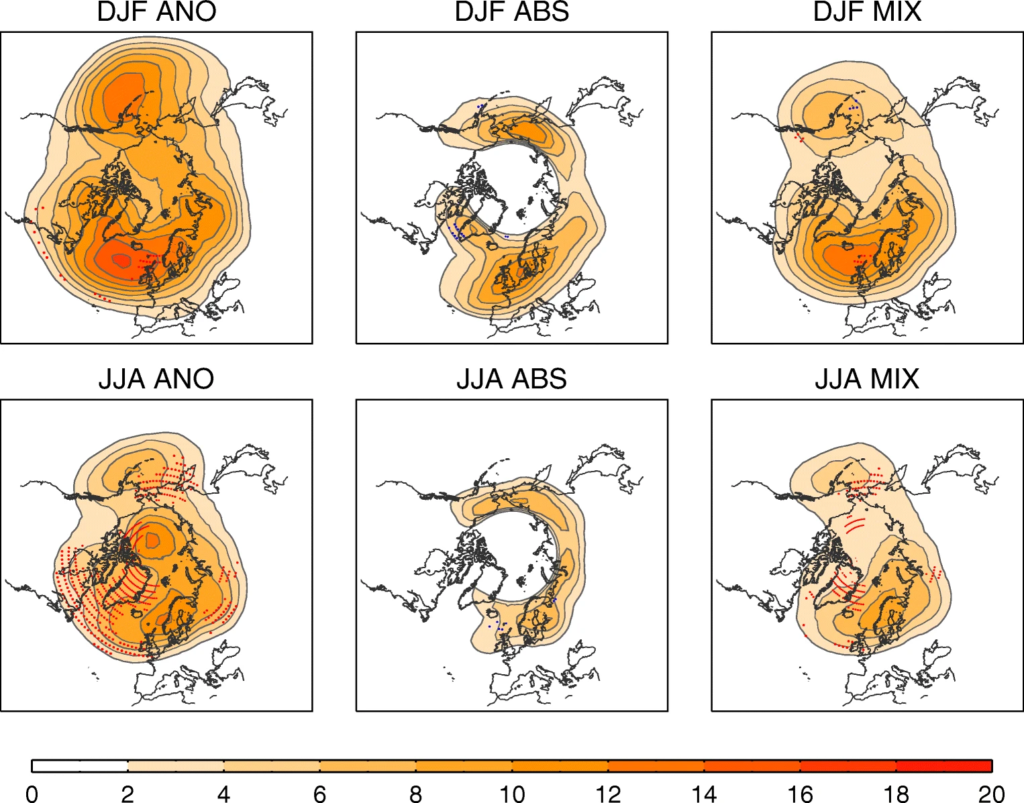
It is worth noting that blocking happens in the southern hemisphere, too, adds Woollings:
“[Blocking] tends to be less persistent in the southern hemisphere as the westerly jets are stronger. Despite this, they do have some important impacts, such as over Australia, New Zealand and southern South America.”
For example, blocking events were behind the record hot, dry weather that saw devastating bushfires during Australia’s 2019-20 summer, and a major drought in southeastern Brazil in 2014-15.
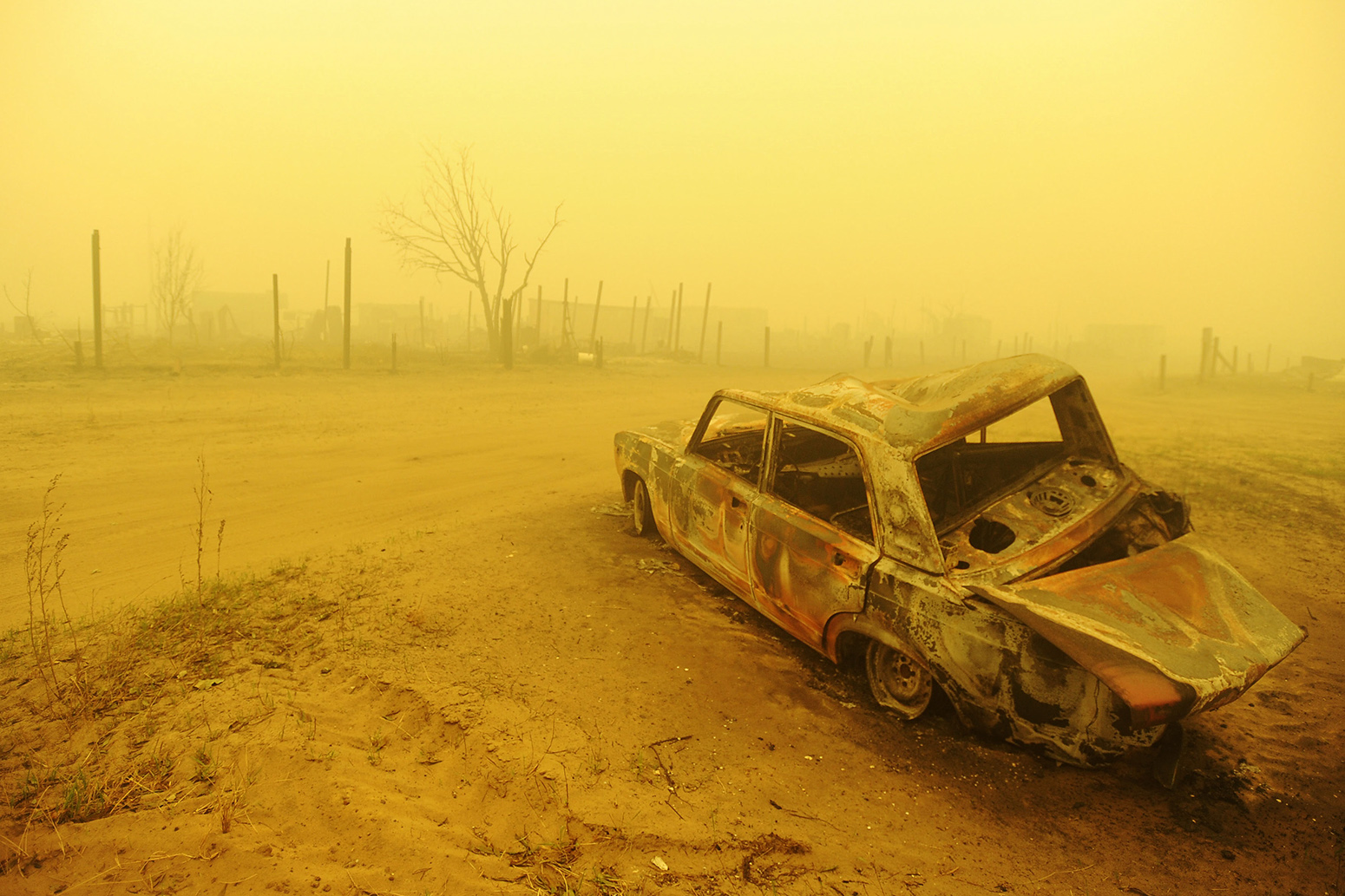
What causes blocking?
So how do these blocking weather patterns arise? Woollings points out that “there are several different mechanisms involved and the balance between these seem to be different in different regions“.
In general, however, “Rossby waves” in the atmosphere are “thought to be crucial”, says Woollings. Rossby waves – named after Carl-Gustaf Rossby, the Swedish-born American meteorologist who identified them – are giant meanders in the jet stream that stretch across the mid-latitudes. They are also known as “planetary waves”.
Rossby waves are a natural phenomenon that form as a result of the rotation of the Earth. As they are a feature of rotating fluids, they are also observed in the oceans and in other planets, such as gas giants Jupiter and Saturn.
Blocking weather patterns can occur when Rossby waves “become amplified and/or break”, says Woollings. Amplified Rossby waves can be seen in a “wavy” jet stream. This tends to slow the east-to-west progression of weather systems, making conditions more persistent and, potentially, allowing blocks to form.
An example is the “omega block”, so-called because it resembles the uppercase letter omega (Ω) in the Greek alphabet. In this shape, alternating areas of high and low pressure form in the peaks and troughs of the Rossby waves, respectively.
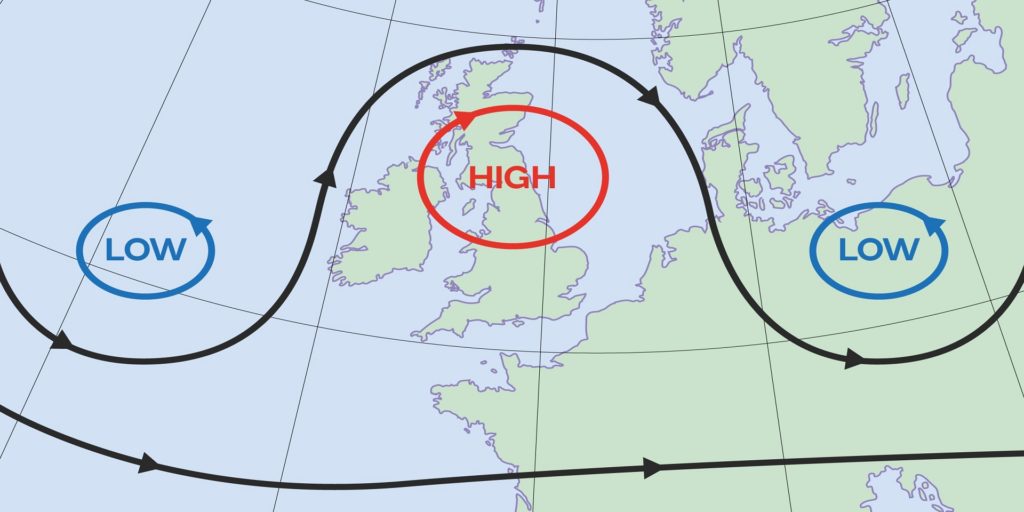
The video below, by the UK Met Office, explains how omega blocks – and an alternative form of blocking called the “diffluent block” – can form over the UK. (There are several other patterns of blocking too.)
A block interrupts the prevailing flow of westerly winds, which typically bring in mild air during winter and cooler, fresher conditions in summer. Therefore, it opens up the potential for more extreme conditions, depending on which type of weather system is overhead.
In the summer of 2010, for example, an omega block left a high-pressure system sitting over western Russia for much of July and August. The resulting heatwave saw most of western Russia record its hottest summer in history. As a 2011 paper on the event explains:
“The heat over Russia produced many days where the high temperature was greater than 40C (104F). Russia had a record-warm summer, with Moscow averaging near +18C and +16C above normal for the months of July and August, respectively.”
The hot, dry and still weather also brought the worst drought conditions in roughly 40 years. In total, the heat, wildfires and associated poor air quality caused at least 56,000 deaths in Moscow and other parts of western Russia.
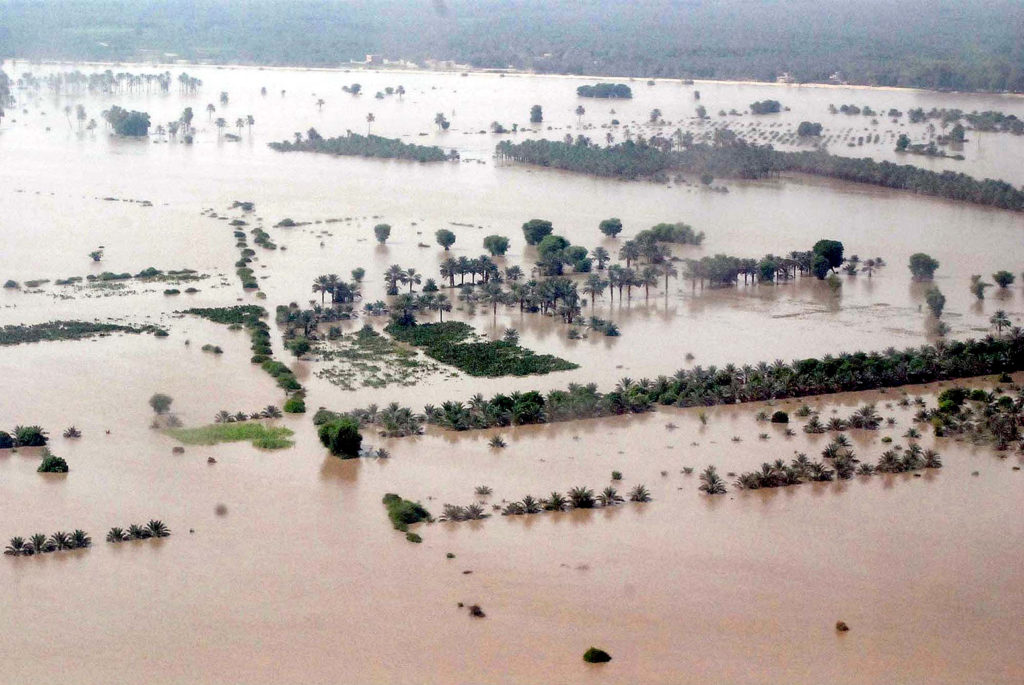
But while Russia was baking in the heat, a few thousands miles to the southeast, Pakistan was sitting under a low-pressure system that was part of the same omega block. Unusual wind patterns caused by the block pushed monsoon rains north and west, bringing heavy rains to northern parts of Pakistan.
Nationwide rainfall totals for Pakistan were 70% above average in July and 102% above in August. The resulting floods affected more than 18 million people, caused 1,985 deaths and damaged or destroyed 1.7m houses.
Have blocking events changed as the climate has warmed?
As blocking events can bring such extreme conditions, an important question is how their frequency and severity is being – and is likely to be – affected by a warming climate.
However, there are a couple of reasons why this is less than straightforward. First, there is no set definition for a block, explains Woollings:
“Blocks come in various shapes and forms, so that while meteorologists would all agree on what a cyclone is, there are often different views on whether a particular weather pattern should be classed as a block or not.”
The 2018 review paper by Woollings and colleagues – mentioned earlier – noted that a “bewildering range of indices” have been developed to identify blocking events. It added:
“A major weakness in dynamical meteorology is that there is currently no comprehensive theory capturing the different processes acting at all stages of the blocking life cycle: onset, maintenance and decay.”
This makes it more difficult to monitor and track changes in blocking events, as well as directly compare results from different studies.
Second, “blocking is a sporadic weather pattern and, hence, highly variable from year to year, even from decade to decade”, says Woollings. This means that blocking events will naturally vary a lot from one year – or decade – to another, so a clear view on any long-term trend is muddied by short-term fluctuations.
Overall, Woollings says “there are no clear trends in blocking seen against this noise”. Shaffrey agrees:
“Historical weather records suggest that blocking hasn’t changed significantly over the past few decades. However, this is somewhat dependent on the method used to define blocking events.”
One possible exception is over Greenland, Woollings notes, which has seen an increase in summer blocks since the 1990s. However, it is not yet clear whether this is down to natural variability or not, he says:
“Several methods give about a 1-in-20 chance of this trend occurring by chance, so it seems interesting. But then, if you test 20 different combinations of region and season, you would indeed expect one of these to show such a change purely by chance.”
A 2018 paper says the increase in blocking could have “been triggered by low-level regional warming promoted by surface feedbacks” – such as increased snowmelt and ice melt on Greenland, and Arctic regional sea ice losses – or changes in the jet stream, but this is currently “unknown”.
How might climate change affect blocking in future?
For scientists making projections of how blocking might be affected by continuing climate change, there is another hurdle: climate models generally struggle with simulating blocking, and have the tendency to underestimate both the frequency and duration of events.
In general, models “predict a general decrease in blocking occurrence in the future”, says Woollings. He explains:
“The dynamics of blocking is focused up at jet-stream level in the atmosphere and here models predict the strongest warming in the tropics. This strengthens the jet-stream winds, making it harder for blocks to form.”
Earlier this year, for example, Woollings discussed in a Carbon Brief guest post how recent tropical warming has changed the pattern of Rossby waves, which contributed to the deadly 2010 Russia heatwave.
However, while there is “good agreement between models” on this theory, Woollings warns that “we should still be cautious because it is not clear that the models are capturing the physics correctly”.
The maps below – also from the 2018 review paper – show projections for northern-hemisphere blocking in winter (top) and summer (bottom), according to three different methods of characterising blocking events. The shading indicates projected increases (orange) and decreases (blue) in the percentage of blocking days in the season, between 1961-90 and 2061-90, under the very high emissions RCP8.5 scenario.

The maps highlight the regional differences in the projections. As Shaffrey explains:
“For example, wintertime blocking over western Europe is projected to decrease slightly, while blocking is expected to increase in eastern Europe associated with shifts in the jet stream over the North Atlantic Ocean.”
For the summer, the maps suggest that blocking will shift polewards, reducing the number of events in the mid-latitudes, but increasing them in high latitudes. This is reflected in other research, too.
Model projections also indicate declines in blocking for the southern hemisphere. A 2019 study, for example, estimated that the number of winter blocked days over Australia and New Zealand could fall by about one third by the end of the 21st century under RCP8.5.
It is worth noting that the projected declines in blocking are “quite gradual”, says Woollings, which means it is “not going to go away any time soon”:
“Blocking will likely play a central role in extreme weather events over the coming decades, particularly mid-latitude heatwaves.”
An angle that has received less attention is regarding the size of blocking events. But research published in 2019 suggests that the spatial extent of blocks is likely to increase with climate change.
Using two climate models and the RCP8.5 scenario, the researchers project that the area of blocking events could increase by up to 17% and 7% in the northern hemisphere summer and winter, respectively (by 2076-2100, compared to 1981-2005). For the southern hemisphere, projections indicate a decline in block area in summer (up to 2%) and an increase in winter (up to 8%).
The reason for the increase in size is down to expected changes in different characteristics of the jet stream, explains co-author Dr Pedram Hassanzadeh from Rice University in the US. He tells Carbon Brief:
“Specifically, we found that the speed of the jet stream’s winds, the latitude of the jet and the width of the jet determine the size of the blocking events. All these three characteristics of the jet streams are known to change as the climate warms.”
For example, he says, “over the North Atlantic region in summers, the jet stream becomes wider and shifts to the north, leading to an increase in the size of the Euro-Atlantic blocking events”. And over the North Pacific region in winters, “the jet stream becomes wider and faster and shifts to the north, all together leading to larger blocking events over the western Pacific Ocean and eastern North America”.
Hassanzadeh’s ongoing work also suggests that moisture levels can affect the size of blocking events. As a warmer climate is likely to bring more evaporation and a warmer atmosphere can hold more moisture, this could also affect blocking events. Hassanzadeh and his colleagues are “currently working on validating this hypothesis and understanding the mechanism”, he says.
(A study from 2015 was the first to suggest that moisture is important for blocking more generally. Woollings describes this as “one of the biggest new ideas on blocking in recent years”.)
The risk of larger blocking events is that they could lead to extreme events that affect more people, Hassanzadeh says:
“Blocking events can cause, among other weather extremes, severe heatwaves in summer. If the blocking events get bigger, we can expect heatwaves that cover a larger area and thus have more impact on the public health and wider ecosystem.”
What role does a warming Arctic play?
While models – tentatively – suggest that blocking events could decline in the mid-latitudes, there is also a prominent theory that a rapidly warming Arctic could bring more of them.
The Arctic is warming more than twice as quickly than the global surface average. This phenomenon is known as “Arctic amplification”. In part, this stems from the rapid loss of sea ice cover in the region – as the ice diminishes, energy from the sun that would have been reflected away by the bright white ice is instead absorbed by the ocean, causing further warming. (Declining snow cover over Arctic land areas has the same effect.)
There are some theories that these rapid changes in the Arctic “might influence the frequency of blocking events”, explains Shaffrey:
“The theories suggest that as the Arctic warms, changes in the strength and position of the northern hemisphere jet stream will allow blocking events to become more frequent.”
For example, as the strength of the jet stream is driven by the difference in temperature between the cold air over the Arctic to the north and the milder air to the south, a fast-warming Arctic reduces this temperature difference.
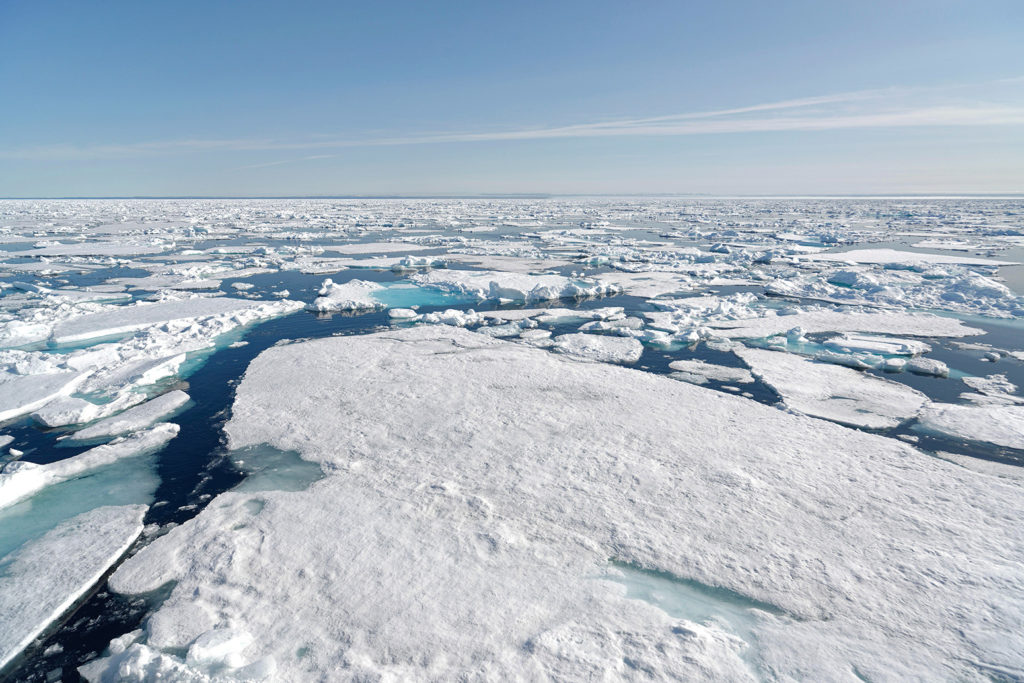
This could weaken the jet stream, making it more susceptible to developing the large meanders that allow blocks to form.
There are other mechanisms of how a warming Arctic could affect the mid-latitudes, which Carbon Brief explored in a detailed Q&A in early 2019.
Research has suggested that Arctic amplification has contributed to some recent mid-latitude extremes in the northern hemisphere – including very cold winters in the US and Asia and the Russian 2010 heatwave.
However, “there’s still a lot of debate in the scientific literature about whether these theories are supported by observations and climate-model experiments”, says Shaffrey.
And any impact that the Arctic has could be outweighed by influences from elsewhere, adds Woollings:
“As Arctic warming strengthens, we expect it to impact the jet stream and this could act to increase blocking in some regions. Climate models currently suggest the competing influence of the warming tropics will be more important, consistent with an overall decrease in blocking.”
Nonetheless, Woollings concludes: “Arctic warming is one of the processes in the mix of several which will shape blocking behaviour in the future.”

